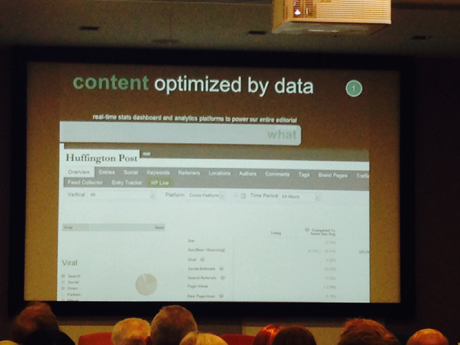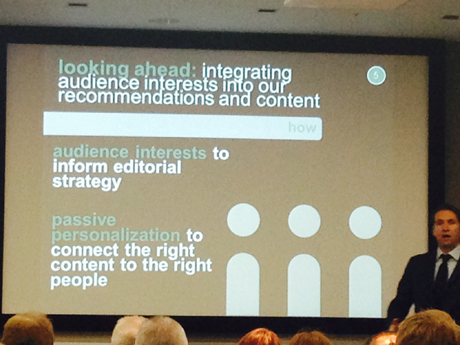Jimmy Maymann, chief executive of The Huffington Post, shared those figures while speaking at the Reuters's Institute Big Data for Media conference in London today. For Maymann, the key is using data to improve reader experience, a tactic that will bring both editorial and business benefits.
"Because of how media has changed in the last five years with social and search we've gone from producing 500 to 1,600 news stories every day," Maymann told delegates, and editors have access to data that can inform newsroom decisions in a real-time analytics dashboard.
The content is "optimised" by data, he said, so the editor can understand reader habits better and respond accordingly.

Maymann shared a picture of the analytics dashboard
On the analytics dashboard, editors can see a general overview or look more deeply into specific entries, social media, keywords, referrers, comments, authors, tags and more, all of which he said could give a better understanding of readers.
In one example, he showed a heatmap of when readers are active on mobile, finding that subscribers who were parents were more active in the evening, when their children had gone to bed, and at weekends.
With one story in particular, "10 ways living with a toddler is like being in prison", editors at the Huffington Post found that by waiting to publish in the evening, rather than when it became ready to publish, the story received 24,000 views in seven hours with 41 per cent of traffic coming from social media.
"We use the data to program the day," he said, "and see a bigger surge in traffic and social interest."
A/B testing headlines is also central to how the Huffington Post editors get content in front of more readers, by finding what readers better respond to.
"We always A/B test the headline as that is what changes things, not the story," he said. "We ask if it will get the attention of the reader in a split second."
On the business side, Maymann said semantic technology JULIA (Just a Linguistic Algorithm) had been helping to not only moderate comments, but also better place adverts, to avoid them being placed in ways that may not fit appropriately with the content of an article.

In the near future, Maymann said The Huffington Post wants to understand audience preferences and behaviours even further, to be able to offer them the best possible experience when on the site.
By studying browser behaviour and reader choices, Maymann said the publisher hopes to adopt a form of passive personalisation by which readers will be shown content and advertising that is more relevant to them, which is expected to boost both the editorial and revenue streams of the publisher and the connection the audience has with the outlet.
"We need to use the data to create better user experience and make people want to stay on the site," he said.
Free daily newsletter
If you like our news and feature articles, you can sign up to receive our free daily (Mon-Fri) email newsletter (mobile friendly).









